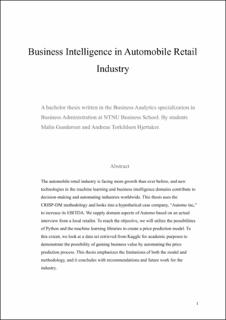Business Intelligence in Automobile Retail Industry
Bachelor thesis

Permanent lenke
https://hdl.handle.net/11250/2998403Utgivelsesdato
2022Metadata
Vis full innførselSamlinger
- NTNU Handelshøyskolen [1634]
Sammendrag
Bilindustrien står overfor mer vekst enn noen gang før, og nye teknologier innen maskinlæring og business intelligence-domener bidrar til beslutningstaking og automatiseringsindustri over hele verden. Denne oppgaven bruker CRISP-DM-metodikk og ser på et hypotetisk case-selskap, "Automo inc," for å øke deres EBITDA. Vi leverer domeneaspekter av Automo basert på en faktisk intervju fra en lokal forhandler. For å nå målet vil vi utnytte mulighetene av Python og maskinlæringsbibliotekene for å lage en prisprediksjonsmodell. I denne oppgaven ser vi på et datasett hentet fra Kaggle for å demonstrere muligheten til å oppnå forretningsverdi ved å automatisere prisprediksjonsprosessen. Denne oppgaven vektlegger begrensningene til både modellen og metodikk, og den avsluttes med anbefalinger og fremtidig arbeid forindustrien. The automobile retail industry is facing more growth than ever before, and newtechnologies in the machine learning and business intelligence domains contribute todecision-making and automating industries worldwide. This thesis uses theCRISP-DM methodology and looks into a hypothetical case company, “Automo inc,”to increase its EBITDA. We supply domain aspects of Automo based on an actualinterview from a local retailer. To reach the objective, we will utilize the possibilitiesof Python and the machine learning libraries to create a price prediction model. Tothis extent, we look at a data set retrieved from Kaggle for academic purposes todemonstrate the possibility of gaining business value by automating the priceprediction process. This thesis emphasizes the limitations of both the model andmethodology, and it concludes with recommendations and future work for theindustry.